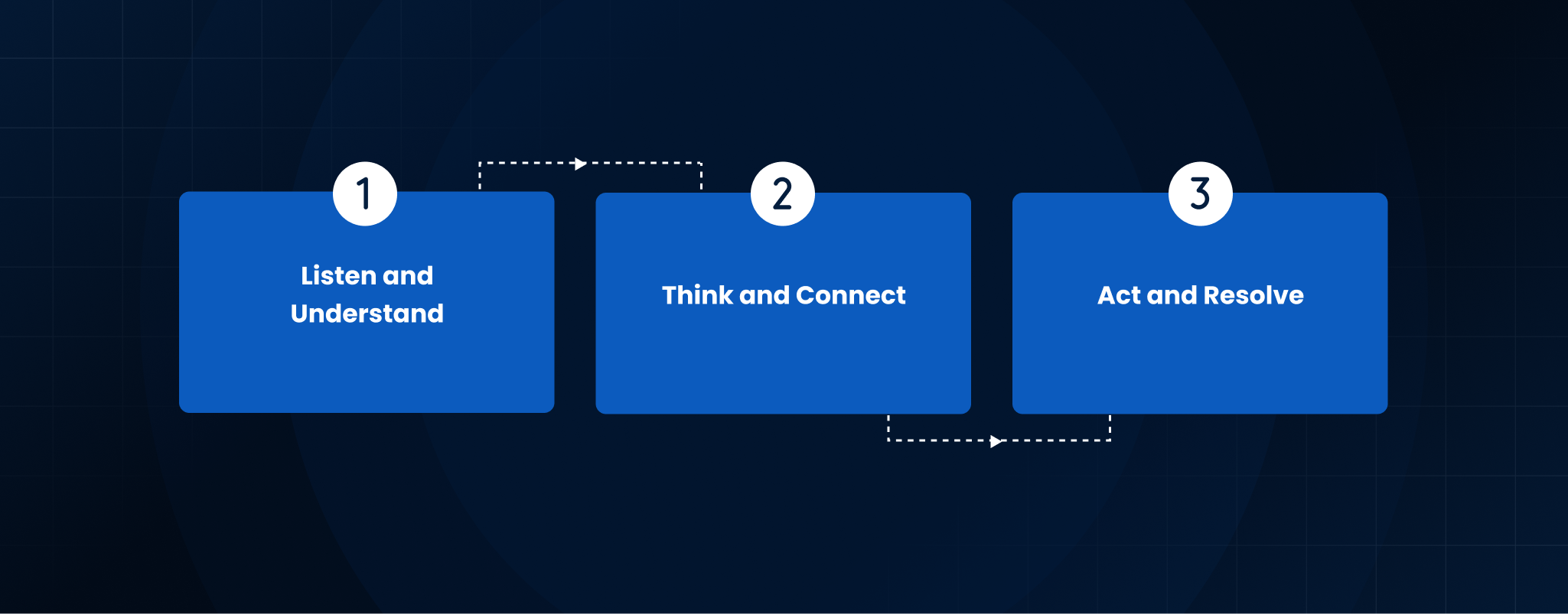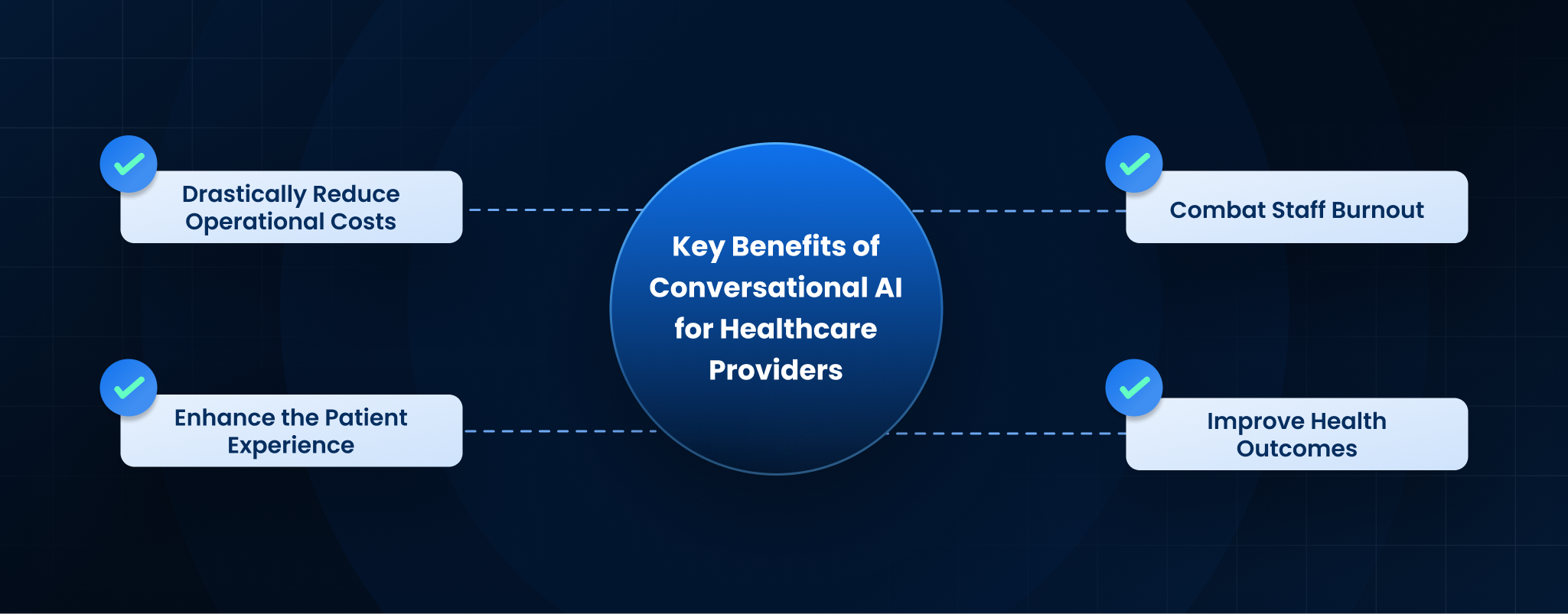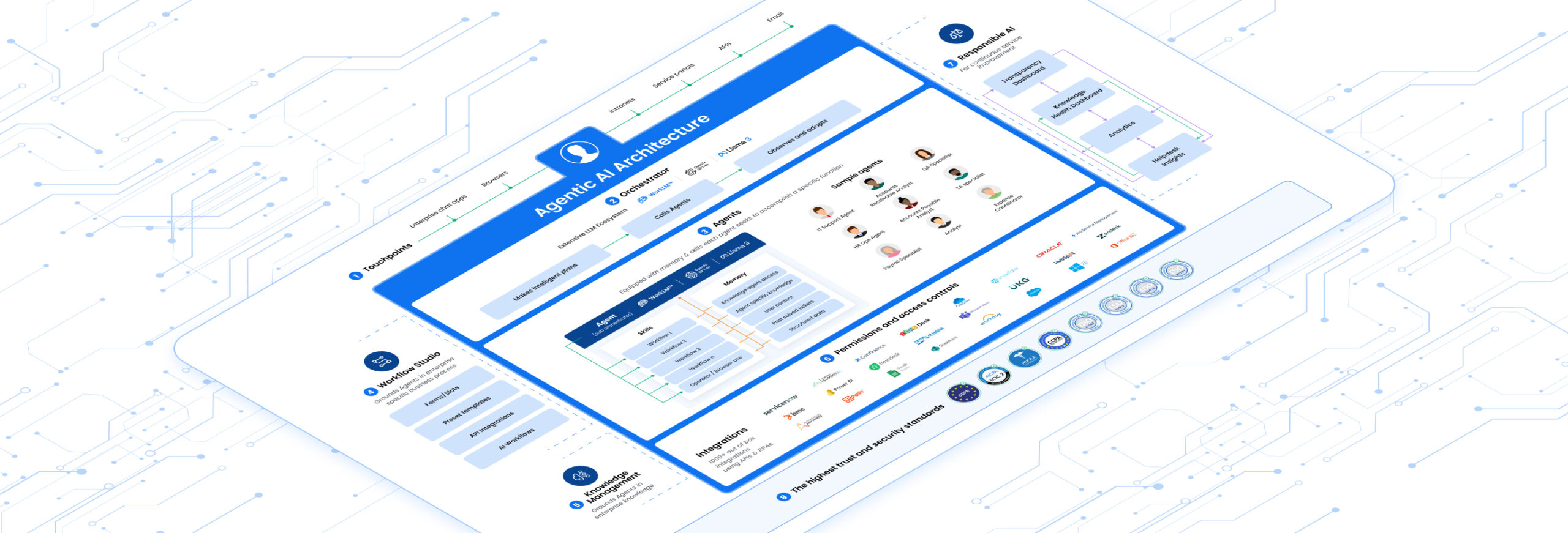Introduction
As a technology leader in a large healthcare organization, you’re constantly balancing three critical demands: enhancing patient care, controlling operational costs, and empowering your staff with technology that actually works. The old ways of managing workflows, endless phone trees, overflowing email inboxes, and complex ticketing systems, are no longer sustainable. This is where conversational AI in healthcare emerges not just as a futuristic idea, but as a practical, powerful solution for today’s biggest challenges.
Think of it as the ultimate digital front door and internal support system, one that’s intelligent, empathetic, and available 24/7. Let’s explore what this technology means for you, your organization, and the future of patient and provider experiences.
What is Conversational AI in Healthcare?
At its heart, conversational AI in healthcare is technology that allows computer programs to understand and respond to human language, both spoken and written, in a natural, human-like way.
Forget those frustrating, keyword-based chatbots of the past that could only respond with “I’m sorry, I don’t understand.” Modern conversational AI is far more sophisticated. Imagine your most skilled, patient, and knowledgeable service agent. Now, imagine they can be in a million places at once, speak any language, and have instant access to the right information, all while maintaining perfect compliance. That’s the essence of today’s conversational AI. It uses advanced technologies to understand context, intent, and even sentiment, making interactions smooth and genuinely helpful.
How Conversational AI Works in Healthcare Settings
While the technology under the hood is complex, the workflow is elegantly simple. It generally follows a three-step process:
- Listen and Understand: A patient or a staff member initiates a conversation through a channel like your patient portal, a mobile app, or an internal tool like Microsoft Teams. The AI instantly analyzes the message to understand not just the words, but the intent. It knows the difference between “I need to book a check-up” and “I have chest pains.”
- Think and Connect: Next, the AI securely connects with your core systems. For a patient query, this might be your Electronic Health Record (EHR) system to check a doctor’s availability. For a clinician’s request, it might connect to your IT service desk to check the status of a ticket or provision software. This integration is the key to providing real, actionable help.
- Act and Resolve: Finally, the AI provides a resolution. This could be confirming an appointment, providing pre-operative instructions, answering a billing question, or, in the case of an internal request, resolving an IT issue on the spot. If the issue is too complex, the AI seamlessly escalates it to a human agent with all the context of the conversation, so the user never has to repeat themselves.

Key Benefits of Conversational AI for Healthcare Providers
Implementing this technology isn’t just about modernizing your tech stack; it’s about driving tangible business results.
- Drastically Reduce Operational Costs: By automating routine inquiries and tasks, from appointment scheduling to IT password resets, you free up your human agents to focus on high-value, complex issues. This directly translates to lower costs per interaction and improved efficiency.
- Enhance the Patient Experience: Patients get instant, 24/7 answers to their questions without waiting on hold. This accessibility and immediate support lead to significantly higher patient satisfaction and loyalty.
- Combat Staff Burnout: Your clinicians and support staff are your greatest asset. By offloading tedious administrative tasks and providing instant IT support, conversational AI in healthcare gives them back valuable time to focus on what they do best: providing excellent patient care.
- Improve Health Outcomes: Proactive AI can send personalized medication reminders, follow up with patients post-discharge, and provide educational content for chronic disease management. Subsequently, this leads to better patient adherence and a reduction in costly hospital readmissions.

Common Use Cases of Conversational AI in Healthcare
The applications are vast, impacting every corner of your organization. By 2025, leading healthcare systems are deploying AI across two major fronts: the patient journey and internal operations.
For Your Patients (The Digital Front Door)
-
Intelligent Appointment Management: Patients can book, reschedule, or cancel appointments through a simple conversation, with the AI checking doctor availability and patient records in real-time.
-
Symptom Triage and Care Navigation: AI can guide patients through a series of questions to assess their symptoms and recommend the appropriate level of care, whether it’s a telehealth visit, an urgent care appointment, or an emergency room visit.
-
Billing and Insurance Queries: Patients can get instant answers to common questions like “How much do I owe?” or “Is this procedure covered by my insurance?” without ever speaking to a human.
-
Prescription Refill Management: The AI can process refill requests, check for eligibility, and notify the patient when their prescription is ready, all automated and integrated with your pharmacy systems.
For Your Staff (The Invisible Backbone)
-
Clinical IT Support: Imagine a nurse in the middle of a shift who can’t access a patient’s chart. Instead of filing a ticket and waiting, they can simply message an AI agent: “I can’t access patient Smith’s labs in Epic.” The AI can immediately troubleshoot, perform diagnostics, and even reset credentials, resolving the issue in seconds.
-
Onboarding and Training: New hires can ask the AI questions about hospital policies, procedures, and system usage, getting instant, consistent answers and reducing the burden on HR and training staff.
-
Streamlining Administrative Tasks: Staff can use conversational AI to request supplies, check on the status of a maintenance request, or get help with HR-related queries, all from within the tools they already use every day.
Challenges of Implementing Conversational AI in Healthcare
Adopting any powerful new technology comes with hurdles. Being aware of them is the first step to overcoming them.
- Navigating the HIPAA Maze: Protecting Patient Health Information (PHI) is non-negotiable. Therefore, any AI solution must be built on a foundation of robust security, with features like data encryption, access controls, and a clear audit trail. You need a partner who understands HIPAA inside and out.
- The Integration Puzzle: Healthcare systems are notoriously complex and often siloed. A successful AI implementation depends on deep, seamless integration with your EHR and other systems of record. This requires a platform with a flexible, API-first architecture.
- Ensuring Clinical Accuracy: For any patient-facing triage or clinical advice, the AI’s knowledge base must be vetted and approved by medical professionals. Trust and accuracy are paramount.
Conversational AI vs Traditional Patient Communication Methods
The difference is like night and day. While traditional methods are manual and limited, conversational AI is automated and scalable.
| Factor | Traditional Methods (Phone Calls, Emails) | Conversational AI in Healthcare |
| Availability | Business hours only | 24/7 x 365 |
| Response Time | Minutes to hours (with wait times) | Instantaneous |
| Scalability | Limited by staff size | Nearly infinite; handles thousands of queries at once |
| Personalization | Generic, one-size-fits-all | Highly personalized based on user data and history |
| Cost | High cost per interaction | Low cost per interaction |
How Leena AI Supports Conversational AI in Healthcare
While many solutions focus solely on the patient-facing side, at Leena AI, we understand that an exceptional patient experience is impossible without an empowered and efficient internal workforce. The time your clinicians waste on IT issues is time taken away from patients.
This is why we’ve pioneered Agentic AI for IT. It’s the next evolution of conversational AI. Our AI agents don’t just chat, they act. They are autonomous agents that can diagnose issues, orchestrate complex workflows, and resolve employee tickets from start to finish without human intervention.
Imagine a doctor needing access to a specific imaging application. Instead of filing a ticket and waiting for IT to grant permissions, they can simply ask Leena AI. The AI agent verifies their identity, checks their role-based permissions, provisions the access in your system, and notifies the doctor that it’s done, all in under a minute.
By automating your internal IT, HR, and Finance helpdesks with Leena AI, you directly impact the bottom line and, most importantly, give your clinical teams the most valuable resource of all: time.
Future of Conversational AI in the Healthcare Industry
The journey is just beginning. Looking ahead, conversational AI in healthcare will become even more proactive and integrated into the fabric of care delivery.
Expect to see AI moving from reactive support to proactive engagement, identifying at-risk patients and reaching out with personalized care plans. We will also see the rise of ambient AI scribes that listen to doctor-patient conversations and automatically document the encounter in the EHR, finally freeing doctors from administrative burdens. Ultimately, this technology will be the central nervous system of a more connected, efficient, and patient-centric healthcare ecosystem.
In conclusion, adopting conversational AI in healthcare is no longer a question of if, but how. By starting with high-impact areas like patient services and internal support, you can build a foundation for a more intelligent and responsive healthcare future.
Frequently Asked Questions about Conversational AI in Healthcare
How does conversational AI in healthcare ensure patient data privacy?
Top-tier platforms are designed with a security-first mindset. They use end-to-end encryption, robust access controls, and are hosted in HIPAA-compliant environments. Furthermore, advanced solutions can de-identify data used for analysis to ensure PHI is never exposed.
What's the first step to implementing conversational AI in healthcare?
The best approach is to start with a specific, high-volume use case, such as appointment scheduling or IT helpdesk automation. This allows you to demonstrate value quickly, learn the process, and then scale your implementation across the organization.
Can conversational AI in healthcare integrate with our existing EHR system?
Yes, absolutely. Modern conversational AI platforms are built with robust APIs designed to integrate seamlessly with major EHR systems like Epic and Cerner, as well as other enterprise software. This integration is critical for a successful deployment.
How does conversational AI in healthcare differ from a basic website chatbot?
A basic chatbot follows a rigid script and can’t handle complex queries. In contrast, conversational AI understands intent, context, and sentiment. It integrates with backend systems to perform actions and can manage complex, multi-turn conversations, providing a far more useful and human-like experience.
What is the typical ROI for conversational AI in healthcare projects?
While it varies, organizations often see a significant return on investment within the first 12-18 months. ROI is driven by reduced call center volume, increased staff productivity, lower cost-per-interaction, and improved patient retention.
Is conversational AI in healthcare difficult for non-technical patients and staff to use?
Not at all. The entire point of this technology is to make interaction intuitive and easy. Because it’s based on natural language, users can simply type or speak their request just as they would to a person, making it accessible to everyone, regardless of their technical skill.
How can we ensure the clinical information provided by conversational AI in healthcare is accurate?
This is a critical point. Any AI that provides clinical guidance or triage must be built on a knowledge base that is curated, vetted, and continuously updated by a team of medical professionals. The AI’s responses should always be based on these approved clinical protocols.













